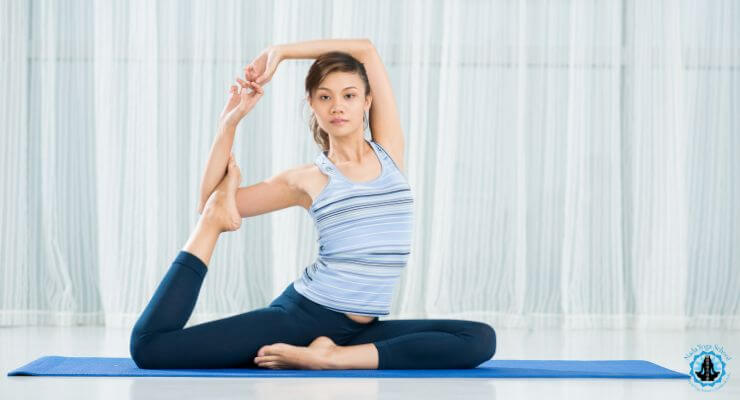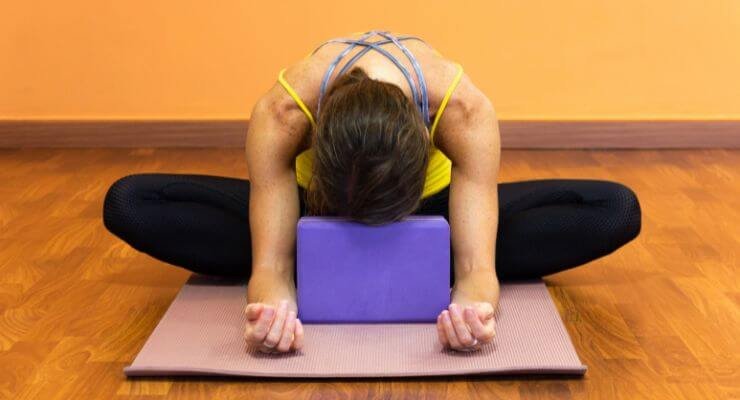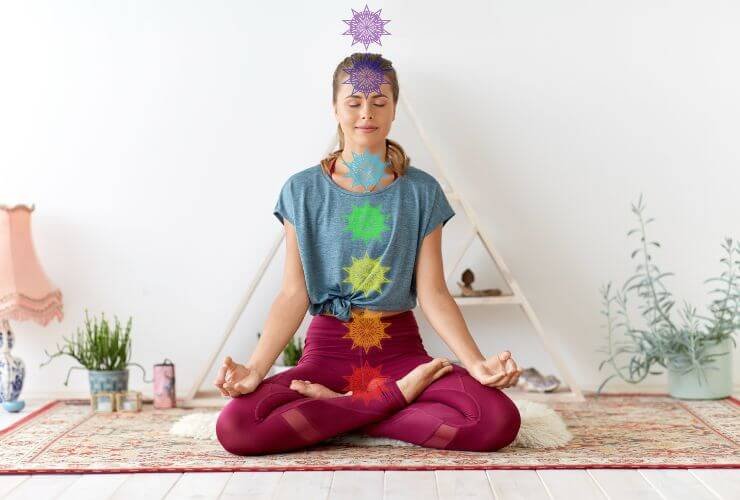When it comes to yoga, one of the most common questions that arises is how long to hold a yoga pose.
It’s a valid question, as holding a pose for too little or too long can affect the effectiveness of the practice.
The answer, however, is not black and white and depends on various factors.
Factors that affect how long to hold a yoga pose include the individual’s experience level, the type of yoga being practiced, and the specific pose itself.
For beginners, it’s recommended to hold poses for shorter durations, while more experienced practitioners can hold poses for longer periods.
The type of yoga being practiced also plays a role, as some styles emphasize holding poses for longer durations, while others focus on flowing movements.
Finally, certain poses may require longer or shorter hold times depending on their difficulty level and the individual’s physical abilities.
Overall, determining how long to hold a yoga pose requires a balance between challenging oneself and listening to one’s body.
Holding a pose for too long can lead to injury or strain, while not holding it long enough may not provide the desired benefits.
By considering individual factors and adjusting hold times accordingly, practitioners can optimize their yoga practice and reap the rewards of this ancient practice.
Understanding Yoga Poses
What is a Yoga Pose?
A yoga pose, also known as an asana, is a physical posture or position that is practiced in yoga.
There are many different types of yoga poses, each with its own unique benefits and challenges.
Some poses are designed to stretch and strengthen specific muscles, while others focus on improving balance, flexibility, and overall body awareness.
Yoga poses are typically held for a certain amount of time, ranging from just a few seconds to several minutes.
The length of time you hold a pose can depend on a variety of factors, including your level of experience, your physical abilities, and the type of yoga you are practicing.
Benefits of Holding Yoga Poses
Holding yoga poses for an extended period of time can provide a variety of benefits for both the mind and body. Here are just a few of the many benefits of holding yoga poses:
- Improved Flexibility: Holding yoga poses can help to improve flexibility by stretching and lengthening the muscles and connective tissues in the body.
- Increased Strength: Many yoga poses require you to hold your body weight in a specific position, which can help to build strength and endurance in the muscles.
- Better Balance and Stability: Practicing yoga poses that require balance can help to improve your overall balance and stability, which can be beneficial in daily life.
- Reduced Stress and Anxiety: Holding yoga poses can help to calm the mind and reduce feelings of stress and anxiety.
- Improved Body Awareness: Practicing yoga poses can help to improve your overall body awareness, allowing you to better understand and connect with your body.
Overall, holding yoga poses can be a challenging yet rewarding practice that can provide a variety of benefits for both the mind and body.
Factors Determining Pose Duration
When it comes to determining how long to hold a yoga pose, there are several factors to consider. Two of the most important factors are personal fitness level and the type of yoga being practiced.
Personal Fitness Level
Each individual has a unique fitness level, which can greatly impact how long they should hold a yoga pose.
Beginners may need to hold poses for a shorter period of time, while more advanced practitioners can hold poses for longer periods without risking injury.
Additionally, individuals with physical limitations or injuries may need to modify poses or hold them for shorter periods of time to avoid aggravating their condition.
Type of Yoga
Different types of yoga have different philosophies and approaches to holding poses. Some types of yoga, such as Iyengar yoga, emphasize precision and alignment, and may require longer holds to achieve the desired effect.
Other types of yoga, such as Vinyasa or Power yoga, focus more on flowing movements and may require shorter holds to maintain the pace of the practice.
It’s important to understand the principles of the specific type of yoga being practiced to determine the appropriate duration for holding poses.
In summary, the duration of holding a yoga pose is dependent on several factors, including personal fitness level and the type of yoga being practiced.
By considering these factors, practitioners can determine the appropriate duration for holding poses to achieve the desired effect without risking injury.
Recommended Pose Durations
When practicing yoga, it is important to hold poses for an appropriate amount of time to reap the benefits of the practice. The duration of holding a yoga pose varies depending on the level of experience, the type of yoga, and the goals of the individual. In general, beginners should hold poses for a shorter duration, while advanced practitioners can hold poses for a longer time.
Beginner Poses
For beginners, it is recommended to hold poses for about 5-10 breaths, or approximately 15-30 seconds. This duration allows the body to get accustomed to the pose and understand the proper alignment. Holding poses for too long can cause discomfort and strain, which can lead to injury. Some beginner poses include:
- Mountain pose (Tadasana)
- Downward-facing dog (Adho Mukha Svanasana)
- Child’s pose (Balasana)
- Warrior II (Virabhadrasana II)
Intermediate Poses
Intermediate practitioners can hold poses for a longer duration, usually around 30-60 seconds. This duration allows for deeper stretches and increased strength building. Intermediate poses require a greater level of focus and control. Some intermediate poses include:
- Triangle pose (Trikonasana)
- Extended side angle pose (Utthita Parsvakonasana)
- Boat pose (Navasana)
- Crow pose (Bakasana)
Advanced Poses
Advanced practitioners can hold poses for a minute or longer, depending on the pose and personal goals. The advanced poses require a high level of strength, flexibility, and balance. It is important to approach advanced poses with caution and proper alignment to prevent injury. Some advanced poses include:
- Headstand (Sirsasana)
- Handstand (Adho Mukha Vrksasana)
- Scorpion pose (Vrschikasana)
- King pigeon pose (Kapotasana)
Remember to listen to your body and adjust the duration of holding poses accordingly. It is better to hold poses for a shorter duration with proper alignment than to hold poses for a longer duration with poor alignment. With practice and patience, one can gradually increase the duration of holding yoga poses.
Safety and Precautions
Yoga is generally considered a safe and beneficial practice for most people.
However, it is important to take certain precautions to avoid injury and ensure a safe practice.
In this section, we will discuss some safety tips and precautions for holding yoga poses.
Listening to Your Body
The most important thing to keep in mind when practicing yoga is to listen to your body. Each person’s body is unique and has different limitations, strengths, and weaknesses. Therefore, it is essential to pay attention to your body’s signals and adjust your practice accordingly.
If you feel any pain or discomfort while holding a pose, it is crucial to back off or modify the pose. Pushing yourself too hard or forcing your body into a pose can lead to injury. Remember that yoga is not a competition, and there is no need to push yourself beyond your limits.
Avoiding Injuries
To avoid injuries while holding yoga poses, it is essential to practice proper alignment and use props when necessary. Proper alignment helps distribute the weight evenly and reduces the risk of strain on the joints and muscles.
Using props such as blocks, straps, and blankets can also help support the body and make the pose more accessible. For example, using a block under the hand in a standing forward fold can help lengthen the spine and reduce strain on the lower back.
It is also important to warm up before holding challenging poses and to cool down afterward. Warming up helps prepare the body for the practice and reduces the risk of injury. Cooling down helps release any tension in the muscles and promotes relaxation.
In conclusion, practicing yoga safely requires listening to your body, practicing proper alignment, using props when necessary, warming up and cooling down, and avoiding pushing yourself beyond your limits.
By following these safety tips and precautions, you can enjoy the benefits of yoga without risking injury.
Conclusion
In conclusion, the ideal amount of time to hold a yoga pose varies depending on the individual’s goals and the type of yoga practice.
The number of breaths used for hold times is a crucial element in yoga practice and a central point of focus while holding a yoga pose.
Beginners should aim to hold each pose for 5-10 breaths, while more advanced practitioners may hold poses for upwards of 5 minutes.
It is important to listen to your body and not push yourself too hard, as yoga is a practice of self-awareness.
Some factors that may affect how long to hold a yoga pose include the intensity of the pose, the individual’s physical abilities, and the individual’s goals. For example, if the goal is to increase flexibility, longer hold times may be beneficial.
It is important to remember that yoga is a personal practice, and what works for one person may not work for another.
Experimenting with different hold times and listening to your body can help you find the ideal amount of time to hold each pose for your individual practice.
Frequently Asked Questions
What are the benefits of holding yoga poses for a long time?
Holding a yoga pose for a longer period of time can help you build strength, improve flexibility, and increase endurance. Additionally, it can help you develop mindfulness and concentration, as you focus on your breath and the sensations in your body.
How long should you hold each yoga pose?
The length of time you should hold each yoga pose depends on your level of experience and the type of yoga you are practicing.
Generally, a short hold time is between 1-2 breaths, a medium hold is between 3-5 breaths, and a long hold is 6 or more breaths.
What are the best yoga poses to hold for a long time?
Some of the best yoga poses to hold for a long time include Warrior II, Downward-Facing Dog, Tree Pose, and Chair Pose. These poses can help build strength and endurance, improve balance and flexibility, and increase mindfulness and concentration.
How many times should you do each yoga pose?
The number of times you should do each yoga pose depends on your personal goals and the type of yoga you are practicing. Generally, it is recommended to do each pose 2-3 times, holding each pose for a few breaths.
How long should a yoga session be?
The length of a yoga session can vary depending on your personal goals and the type of yoga you are practicing. Generally, a yoga session can range from 30 minutes to 90 minutes.
What are some standing yoga poses to hold for a long time?
Some standing yoga poses to hold for a long time include Warrior II, Tree Pose, Chair Pose, and Extended Triangle Pose. These poses can help build strength in the legs and core, improve balance and flexibility, and increase mindfulness and concentration.





